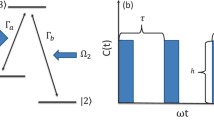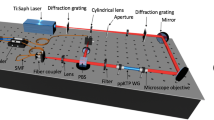Abstract
We revisit the coherent population trapping (CPT) of a three-state system in the presence of environmental fluctuations and strong electromagnetic driving fields. To this end, we use a fluctuation-regulated quantum master equation that considers the drive-induced dissipation (DID) in the system. The DID originates from the combined effect of a driving field and environmental fluctuations. We report that increasing DID shows a narrowing of CPT linewidth and, hence, improved selection of the dark states. As such, the DID enhances the sensitivity of CPT at a driving strength much larger than the system’s relaxation rates. We also discuss the practical implementation of the scheme along with possible applications.
Graphic abstract
The figure shows the narrowing of CPT responance (narrow dark region) as the environmental fluctuation correlation \(\tau _c\) and hence, the drive-induced dissipation increases.





Similar content being viewed by others
Data Availibility Statement
This paper has no associated data or the data will not be deposited. All the relevant data are within the paper.
References
M.O. Scully, S.-Y. Zhu, A. Gavrielides, Degenerate quantum-beat laser: lasing without inversion and inversion without lasing. Phys. Rev. Lett. 62(24), 2813–2816 (1989). https://doi.org/10.1103/PhysRevLett.62.2813
W. Tan, W. Lu, R.G. Harrison, Lasing without inversion in a v system due to trapping of modified atomic states. Phys. Rev. A 46(7), 3613–3616 (1992). https://doi.org/10.1103/PhysRevA.46.R3613
M.O. Scully, M. Fleischhauer, High-sensitivity magnetometer based on index-enhanced media. Phys. Rev. Lett. 69(9), 1360–1363 (1992). https://doi.org/10.1103/PhysRevLett.69.1360
J. Belfi, G. Bevilacqua, V. Biancalana, Y. Dancheva, L. Moi, All optical sensor for automated magnetometry based on coherent population trapping. J. Opt. Soc. Am. B JOSAB (2007). https://doi.org/10.1364/JOSAB.24.001482
A.-L. Yang, G.-Q. Yang, Y.-F. Xu, Q. Lin, High contrast atomic magnetometer based on coherent population trapping. Chin. Phys. B 23(2), 027601 (2014). https://doi.org/10.1088/1674-1056/23/2/027601
S.A. Zibrov, I. Novikova, D.F. Phillips, R.L. Walsworth, A.S. Zibrov, V.L. Velichansky, A.V. Taichenachev, V.I. Yudin, Coherent-population-trapping resonances with linearly polarized light for all-optical miniature atomic clocks. Phys. Rev. A 81(1), 013833 (2010). https://doi.org/10.1103/PhysRevA.81.013833
Y. Hu, Y.Y. Feng, C. Xu, H.B. Xue, L. Sun, Loop-locked coherent population trapping magnetometer based on a fiber electro-optic modulator. Appl. Opt. 53(10), 2158–2162 (2014). https://doi.org/10.1364/AO.53.002158
S.-H. Wu, E. Turner, H. Wang, Continuous real-time sensing with a nitrogen-vacancy center via coherent population trapping. Phys. Rev. A 103(4), 042607 (2021). https://doi.org/10.1103/PhysRevA.103.042607
G. Alzetta, A. Gozzini, L. Moi, G. Orriols, An experimental method for the observation of R.F. transitions and laser beat resonances in oriented Na vapour. Il Nuovo Cimento B (1971–1996) 36(1), 5–20 (1976). https://doi.org/10.1007/BF02749417
H.R. Gray, R.M. Whitley, C.R. Stroud, Coherent trapping of atomic populations. Opt. Lett. 3(6), 218 (1978). https://doi.org/10.1364/OL.3.000218
E. Arimondo, G. Orriols, Nonabsorbing atomic coherences by coherent two-photon transitions in a three-level optical pumping. Lettere al Nuovo Cimento (1971-1985) 17(10), 333–338 (1976). https://doi.org/10.1007/BF02746514
G.S. Agarwal, Coherent population trapping states of a system interacting with quantized fields and the production of the photon statistics matched fields. Phys. Rev. Lett. 71(9), 1351–1354 (1993). https://doi.org/10.1103/PhysRevLett.71.1351
A.J. Ramsay, T.M. Godden, S.J. Boyle, E.M. Gauger, A. Nazir, B.W. Lovett, A.M. Fox, M.S. Skolnick, Phonon-induced Rabi-frequency renormalization of optically driven single \(\rm InGaAs/\rm GaAs\rm \) Quantum Dots. Phys. Rev. Lett. 105, 177402 (2010). https://doi.org/10.1103/PhysRevLett.105.177402
A. Chakrabarti, R. Bhattacharyya, Non-Bloch decay of Rabi oscillations in liquid state NMR. EPL (Europhys. Lett.) 121, 57002 (2018). https://doi.org/10.1209/0295-5075/121/57002
L. D’Alessio, M. Rigol, Long-time behavior of isolated periodically driven interacting lattice systems. Phys. Rev. X 4(4), 041048 (2014). https://doi.org/10.1103/PhysRevX.4.041048
D.A. Abanin, W. De Roeck, F. Huveneers, Exponentially slow heating in periodically driven many-body systems. Phys. Rev. Lett. 115(25), 256803 (2015). https://doi.org/10.1103/PhysRevLett.115.256803
A. Rubio-Abadal, M. Ippoliti, S. Hollerith, D. Wei, J. Rui, S.L. Sondhi, V. Khemani, C. Gross, I. Bloch, Floquet prethermalization in a bose-hubbard system. Phys. Rev. X 10, 021044 (2020). https://doi.org/10.1103/PhysRevX.10.021044
E. Arimondo, V Coherent population trapping in laser spectroscopy. Prog. Opt. 35, 257–354 (1996). https://doi.org/10.1016/S0079-6638(08)70531-6
I.V. Jyotsna, G.S. Agarwal, Coherent population trapping at low light levels. Phys. Rev. A 52(4), 3147–3152 (1995). https://doi.org/10.1103/PhysRevA.52.3147
I.V. Jyotsna, G.S. Agarwal, Dynamics of coherent population trapping states in dense systems. Phys. Rev. A 53(3), 1690–1696 (1996). https://doi.org/10.1103/PhysRevA.53.1690
A. Chakrabarti, R. Bhattacharyya, Quantum master equation with dissipators regularized by thermal fluctuations. Phys. Rev. A 97(6), 063837 (2018). https://doi.org/10.1103/PhysRevA.97.063837
N. Chanda, R. Bhattacharyya, Optimal clock speed of qubit gate operations on open quantum systems. Phys. Rev. A 101(4), 042326 (2020). https://doi.org/10.1103/PhysRevA.101.042326
N. Chanda, R. Bhattacharyya, Emergence of the Born rule in strongly driven dissipative systems. Phys. Rev. A 104(2), 022436 (2021). https://doi.org/10.1103/PhysRevA.104.022436
A. Chatterjee, R. Bhattacharyya, Nonlinearity and temperature dependence of drive-induced shifts in a thermal environment. Phys. Rev. A 102(4), 043111 (2020). https://doi.org/10.1103/PhysRevA.102.043111
S. Saha, R. Bhattacharyya, Time-periodic interaction between a spin-pair: a quantum master equation approach. J. Magn. Resonan. Open 10–11, 100046 (2022). https://doi.org/10.1016/j.jmro.2022.100046
S. Saha, R. Bhattacharyya, Effects of dipolar coupling on an entanglement storage device. J. Phys. B: At. Mol. Opt. Phys. 55(23), 235501 (2022). https://doi.org/10.1088/1361-6455/ac9a18
S. Saha, R. Bhattacharyya, Cascaded dynamics of a periodically driven dissipative dipolar system. Phys. Rev. A 107, 022206 (2023). https://doi.org/10.1103/PhysRevA.107.022206
A. Chakrabarti, R. Bhattacharyya, Emergence of prethermal states in a driven dissipative system through cross-correlated dissipation. Europhys. Lett. 142(5), 55001 (2023). https://doi.org/10.1209/0295-5075/acd4e5
P. Tamarat, B. Lounis, J. Bernard, M. Orrit, S. Kummer, R. Kettner, S. Mais, T. Basché, Pump-probe experiments with a single molecule: ac-stark effect and nonlinear optical response. Phys. Rev. Lett. 75(8), 1514–1517 (1995). https://doi.org/10.1103/PhysRevLett.75.1514
J. Vanier, Atomic clocks based on coherent population trapping: a review. Appl. Phys. B 81(4), 421–442 (2005). https://doi.org/10.1007/s00340-005-1905-3
M.D. Lukin, S.F. Yelin, M. Fleischhauer, M.O. Scully, Quantum interference effects induced by interacting dark resonances. Phys. Rev. A 60(4), 3225–3228 (1999). https://doi.org/10.1103/PhysRevA.60.3225
F. Renzoni, A. Lindner, E. Arimondo, Coherent population trapping in open systems: a coupled/noncoupled-state analysis. Phys. Rev. A 60, 450–455 (1999). https://doi.org/10.1103/PhysRevA.60.450
T. Zinkevich, V. Chevelkov, B. Reif, K. Saalwächter, A. Krushelnitsky, Internal protein dynamics on ps to \(\mu \)s timescales as studied by multi-frequency 15N solid-state NMR relaxation. J. Biomol. NMR 57, 219–235 (2013). https://doi.org/10.1007/s10858-013-9782-2
D. Huster, L. Xiao, M. Hong, Solid-state NMR investigation of the dynamics of the soluble and membrane-bound colicin ia channel-forming domain. Biochemistry 40(25), 7662–7674 (2001). https://doi.org/10.1021/bi0027231
I. Hung, P. Gor’kov, Z. Gan, Using the heteronuclear Bloch-Siegert shift of protons for B1 calibration of insensitive nuclei not present in the sample. J. Magn. Reson. 310, 106636 (2020). https://doi.org/10.1016/j.jmr.2019.106636
Acknowledgements
Authors thank Saptarshi Saha for insightful discussions and helpful suggestions. A. C. acknowledges the University Grants Commission (UGC) of the Government of India for providing financial assistance through senior research fellowship (SRF) with reference ID- 522160.
Author information
Authors and Affiliations
Contributions
AC carried out the analytical and computational work, and RB supervised the work and helped with the manuscript.
Corresponding author
Ethics declarations
Conflict of interest
The authors declare no Conflict of interest.
Rights and permissions
Springer Nature or its licensor (e.g. a society or other partner) holds exclusive rights to this article under a publishing agreement with the author(s) or other rightsholder(s); author self-archiving of the accepted manuscript version of this article is solely governed by the terms of such publishing agreement and applicable law.
About this article
Cite this article
Chatterjee, A., Bhattacharyya, R. Improved selection of dark states in the presence of drive-induced dissipation. Eur. Phys. J. D 78, 44 (2024). https://doi.org/10.1140/epjd/s10053-024-00839-1
Received:
Accepted:
Published:
DOI: https://doi.org/10.1140/epjd/s10053-024-00839-1




